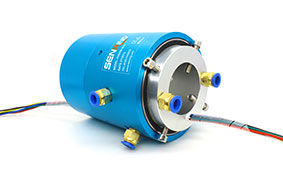How does an electrical optic slip ring work?
An optical slip ring is a device that enables the transmission of light signals between two rotating parts without the use of electrical contacts. It consists of a series of lenses and mirrors that are arranged in a circular pattern around the axis of rotation.The input light signal is focused onto the first lens, which then reflects it onto the next lens in the series. This process continues until the light reaches the final lens, which is located on the opposite side of the axis of rotation. The light is then focused onto a photodetector or other sensor, which converts the light signal into an electrical signal for further processing.

The key advantage of an electrical optic slip ring is that it allows for high-speed data transmission without the need for physical contact between the rotating parts. This makes it ideal for use in applications such as robotics, aerospace, and telecommunications, where reliability and durability are critical. Additionally, optical slip rings are immune to electromagnetic interference, which can be a significant issue in certain environments.
An optical slip ring, also known as a fiber optic rotary joint (FORJ), is a device used to transmit optical signals across a rotating interface. It allows for the transfer of light signals between stationary and rotating parts of a system without the need for physical connections that could impede rotation.
1.Here's how an optical slip ring typically works:
Basic Structure: An optical slip ring consists of two main parts: the stationary side and the rotating side. The stationary side is fixed to the non-rotating part of the system, while the rotating side is attached to the rotating part.
Fiber Optic Cables: The key component of an optical slip ring is the fiber optic cables. These cables are made of glass or plastic fibers that can transmit light signals over long distances with minimal loss.
Optical Coupling: On both the stationary and rotating sides of the slip ring, there are optical components known as couplers. These couplers are designed to align with each other when the slip ring is assembled.
Light Transmission: Light signals, typically in the form of laser or LED pulses, are sent into the fiber optic cables from the stationary side. These light signals travel through the cables to the rotating side.
Rotational Movement: As the rotating part of the system moves, the optical slip ring allows for continuous rotation without twisting or tangling the fiber optic cables. This movement is enabled by the design of the slip ring, which allows the optical components to rotate freely while maintaining alignment.

Optical Coupling Maintenance: The optical couplers on both sides of the slip ring ensure that the light signals are transmitted without interruption as the system rotates. These couplers may use lenses or mirrors to focus and direct the light, maintaining a stable connection even during high-speed rotations.
Signal Integrity: Optical slip rings are designed to minimize signal loss and interference, ensuring high-quality transmission of optical signals across the rotating interface. This is crucial for applications such as data transmission in communication systems, medical equipment, robotics, and aerospace technology.
Overall, an optical slip ring provides a reliable and efficient way to transmit optical signals across rotating interfaces, enabling continuous data transfer without compromising on rotational movement.
For more details on electrical optic slip ring products, please view :https://www.senring.com/fiber-optic-rotary-joints/6-channel-forj/fo608.html
FAQ questions:
1.What is the current rating of a high current slip ring?
2.What is the difference between through hole Slip Ring and carbon brushes?
3.What does the high current slip rings do on a steering wheel?
4.What metal is used in through hole slip rings?
5.Are thorugh hole slip rings usually made of copper?
- How does an electrical optic slip ring work?
-

- 20-03-2024
- An optical slip ring is a device that enables the transmission of light signals between two rotating parts without the use of electrical contacts. It consists o
- more+

 RESOURCES
RESOURCES GET A QUOTE
GET A QUOTE





